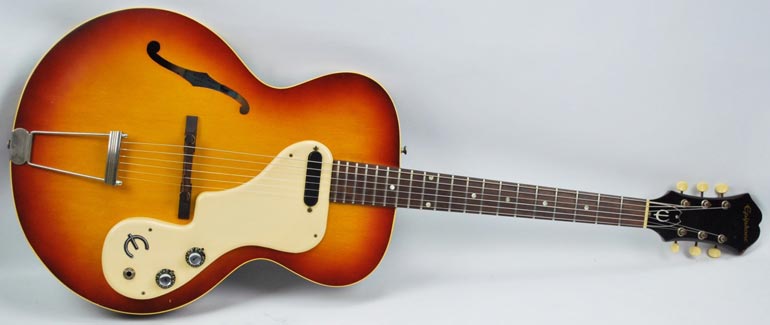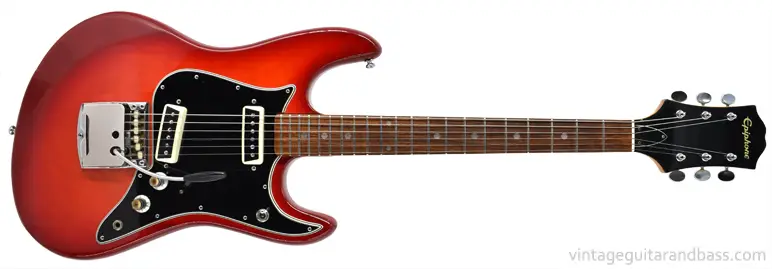
The Epiphone company of New York, USA, was created by the Stathopoulos family, making various musical instruments with the first electric guitar in 1935. In many ways, it was just like rivals Guild and Gibson; a very highly respected guitar manufacturer, producing superb jazz boxes for the top end of the US market. Guitars like the Emperor and Broadway established a fine reputation, which still stands with vintage guitar collectors today. But tragedy occured, with the death of Epaminondas Stathopoulos; the driving force behind Epiphone at the time.

But perhaps the best known guitars built by Epiphone were those manufactured at the Gibson Kalamazoo plant - the CMI period. CMI bought out a struggling Epiphone in 1957, buying tooling, parts, and even unfinished instruments. Production of hollow-bodied jazz guitars and acoustic (upright) basses began immediately. But before long Epiphone was producing new lines, unrelated to the output of previous years. Thinline semi acoustics like the Epiphone Casino, Sorrento, Riviera and Sheraton were soon joined by solid bodies like the Epiphone Wilshire, Crestwood and Coronet; all distributed to dealers that wanted Gibson-quality instruments, but did not qualify to be Gibson stockists themselves.
Gibson ran a whole block in Kalamazoo giving their address as Parsons Street, whilst Epiphone were officially situated on Bush Street; just the other side of the block. The instruments were made side by side, both using the same woods, construction methods, and many of the same components. Numerous Epiphone models had a direct Gibson equivalent that sold at more or less the same price; for example the Epiphone Casino and the Gibson ES330 - or the Epiphone Rivoli and the Gibson EB2 bass. Unlike today, the 1960s US-built Epiphone line was aimed at exactly the same market as the Gibson equivalent instruments.
Epiphone guitars quickly found favour in the mid-1960s music scene; bands like the Beatles, Rolling Stones, Animals and the Kinks all played Epiphones, along with many more. But as the decade ended, CMI gave way to Norlin, and Epiphone production went to Japan.
1970s Epiphones were primarily made in Japan; they were no longer rebranded Gibson guitars, and although still good quality they were aimed at a lower price-point, to compete with the very many imports that were taking so much market share in the financially troubled early seventies. Epiphone chose (arguably) the best of the Japanese manufacturers Matsumoku to build their guitars, and although some of the very earliest designs were not widely regarded by musicians at the time, they rapidly improved, and along with a little celebrity use over the years (Kurt Cobain, Noel Gallagher etc.) are now both collectable and rapidly increasing in price.
The very first 1970s Japanese Epiphones (1802T / 1820 solid body guitar / bass, and 5102T / 5120 semi-acoustic guitar / bass) were similar to pre-existing guitars branded Aria, Conrad, Commodore, Eros, Univox (plus numerous others). Yes, the Epiphone versions had slightly improved appointments but were functionally indistinct. But with every year that passed, these models (and all new releases) improved both in function and appearance, whilst also gradually reverting to the classic Epiphone designs of the 1960s. By the mid 1970s Matsumoku were producing some outstanding Epiphones!

Towards the very end of Norlin's tenure, a few Epiphone guitars were produced at the Kalamazoo and Nashville plants: tentative issues of the Epiphone Doublecut / Spirit; but almost immediately this model was rebranded as the Gibson Spirit.
Today's Epiphone guitars are typically reissues of the 1960s Gibson and Epiphone instruments made in Kalamazoo - but being made in China and Korea these are typically very much cheaper - though generally good quality instruments.
 The Epiphone 1802T was the early name given to the Epiphone ET-270 and derived from an existing Aria guitar, also the 1802T. This was the first of the 1970s Epiphone solid bodies made in Japan by Matsumoku.The model evolved somewhat over its short production run: the very earliest examples were very similar to the Aria, sharing the same body shape, hardware, and clear-coated neck with Fender-style headstock with decal logo. By the time it was designated the Epiphone ET-270 it had been upgraded with the classic Epiphone-style headstock, with nice inlaid logo, and Epiphone 'E' motifs on the truss rod cover and scratchplate. This example from 1971 is somewhere in between with the Epiphone-style headstock, but with silk-screened logo, and no 'E's.
The Epiphone 1802T was the early name given to the Epiphone ET-270 and derived from an existing Aria guitar, also the 1802T. This was the first of the 1970s Epiphone solid bodies made in Japan by Matsumoku.The model evolved somewhat over its short production run: the very earliest examples were very similar to the Aria, sharing the same body shape, hardware, and clear-coated neck with Fender-style headstock with decal logo. By the time it was designated the Epiphone ET-270 it had been upgraded with the classic Epiphone-style headstock, with nice inlaid logo, and Epiphone 'E' motifs on the truss rod cover and scratchplate. This example from 1971 is somewhere in between with the Epiphone-style headstock, but with silk-screened logo, and no 'E's.
 Scan of 1970 Epiphone guitar catalogue produced by Rosetti for the UK market. Undated but most likely from mid-late 1970, this was the first UK catalogue to show the new range of Japanese (Matsumoku) Epiphone guitars. Interestingly, these pages show the Epiphone solid bodies with a single-sided Fender-style headstock layout - a feature quickly replaced with a typical two-sided Epiphone headstock almost immediately. Epiphone electric guitars: 9520, 9525; bass guitars: 9521, 9526; acoustic guitars: 6730, 6830, 6834
Scan of 1970 Epiphone guitar catalogue produced by Rosetti for the UK market. Undated but most likely from mid-late 1970, this was the first UK catalogue to show the new range of Japanese (Matsumoku) Epiphone guitars. Interestingly, these pages show the Epiphone solid bodies with a single-sided Fender-style headstock layout - a feature quickly replaced with a typical two-sided Epiphone headstock almost immediately. Epiphone electric guitars: 9520, 9525; bass guitars: 9521, 9526; acoustic guitars: 6730, 6830, 6834
 By the end of the 1960s, a decision had been made to move Epiphone guitar production from the USA (at the Kalamazoo plant where Gibson guitars were made), to Matsumoto in Japan, creating a line of guitars and basses significantly less expensive than the USA-built models (actually less than half the price). The Matsumoku factory had been producing guitars for export for some time, but the 1820 bass (alongside a number of guitar models and the 5120 electric acoustic bass) were the first Epiphone models to be made there. These new Epiphones were based on existing Matsumoku guitars, sharing body shapes, and hardware, but the Epiphone line was somewhat upgraded, with inlaid logos and a 2x2 peghead configuration. Over the course of the 70s, the Japanese output improved dramatically, and in many ways these early 70s models are a low point for the brand. Having said this, there are a lot worse guitars out there, and as well as being historically important, the 1820 bass can certainly provide the goods when required.
By the end of the 1960s, a decision had been made to move Epiphone guitar production from the USA (at the Kalamazoo plant where Gibson guitars were made), to Matsumoto in Japan, creating a line of guitars and basses significantly less expensive than the USA-built models (actually less than half the price). The Matsumoku factory had been producing guitars for export for some time, but the 1820 bass (alongside a number of guitar models and the 5120 electric acoustic bass) were the first Epiphone models to be made there. These new Epiphones were based on existing Matsumoku guitars, sharing body shapes, and hardware, but the Epiphone line was somewhat upgraded, with inlaid logos and a 2x2 peghead configuration. Over the course of the 70s, the Japanese output improved dramatically, and in many ways these early 70s models are a low point for the brand. Having said this, there are a lot worse guitars out there, and as well as being historically important, the 1820 bass can certainly provide the goods when required.
 When Epiphone production moved from Kalamazoo to the Matsumoku plant in Japan, a whole new range of electric, flattop and classic acoustic guitars was launched. Between late 1970 and 1972 the new models were launched and refined. This 'folder' catalog contains various inserts released over these years detailing four electric six-strings (ET-270, ET-275, ET-278, and thinline EA-250), three bass guitars (ET-280, ET-285, and thinline EA-260), three folk/steel acoustics, four jumbo flattop acoustics, two 12-string jumbos, four classic acoustics, and a banjo.
When Epiphone production moved from Kalamazoo to the Matsumoku plant in Japan, a whole new range of electric, flattop and classic acoustic guitars was launched. Between late 1970 and 1972 the new models were launched and refined. This 'folder' catalog contains various inserts released over these years detailing four electric six-strings (ET-270, ET-275, ET-278, and thinline EA-250), three bass guitars (ET-280, ET-285, and thinline EA-260), three folk/steel acoustics, four jumbo flattop acoustics, two 12-string jumbos, four classic acoustics, and a banjo.
 Schematic and simplified wiring illustration for the 1960s single pickup Gibson EB2 and Epiphone Rivoli bass guitars. The original EB2 and Rivoli basses were very similar indeed, both being made side by side in Gibson's Kalamazoo plant in Michigan, USA. Differences were purely cosmetic, and electronically they were identical: a Gibson EB humbucker, one volume control, one tone control, and a baritone push button switch.
Schematic and simplified wiring illustration for the 1960s single pickup Gibson EB2 and Epiphone Rivoli bass guitars. The original EB2 and Rivoli basses were very similar indeed, both being made side by side in Gibson's Kalamazoo plant in Michigan, USA. Differences were purely cosmetic, and electronically they were identical: a Gibson EB humbucker, one volume control, one tone control, and a baritone push button switch.
 A closer look at a 1966 Epiphone Granada. The non-cutaway Granada was the Epiphone version of the Gibson E120T thinline hollowbody. Both were built side by side in Gibson's Kalamazoo plant, and were the least expensive hollowbodies in their respective ranges. Sales of the Epiphone version were never huge (see Epiphone Granada shipping figures, at least compared to the Gibson, even when an otherwise identical cutaway model, the E444TC, was added. No Gibson cutaway version was released.
A closer look at a 1966 Epiphone Granada. The non-cutaway Granada was the Epiphone version of the Gibson E120T thinline hollowbody. Both were built side by side in Gibson's Kalamazoo plant, and were the least expensive hollowbodies in their respective ranges. Sales of the Epiphone version were never huge (see Epiphone Granada shipping figures, at least compared to the Gibson, even when an otherwise identical cutaway model, the E444TC, was added. No Gibson cutaway version was released.
$295
$1000
$2695
$1200
$500
$3779
$51
$580
$1051
$800
$1299
$2300
$625
$899
$1000
$595
$1100
$800
$1350